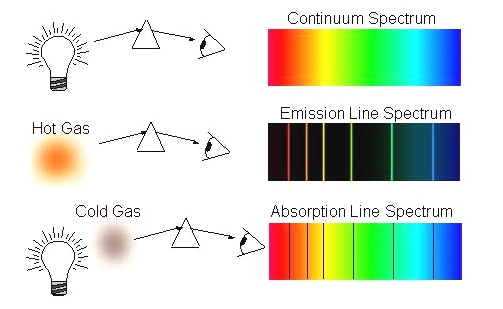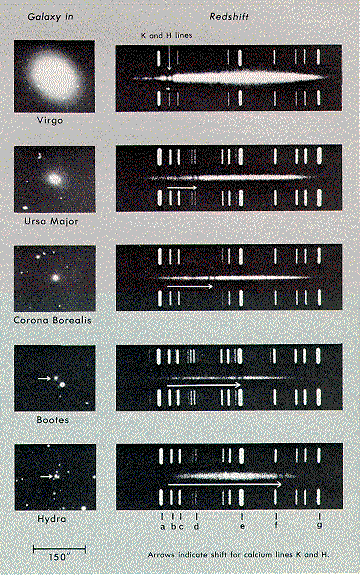 |
Hubble's Law and the Expanding Universe |
In the early 1900's (1910's), an important discovery was made
by V. M. Slipher which was then followed up by Edwin Hubble.
Slipher (and then Hubble) found that all
distant galaxies were receding from the Earth. Actually,
they found that all distant galaxies showed redshifts which
they inferred to mean that the galaxies were moving away from us.
Question: How did Slipher and Hubble
Accomplish this Feat?


|
Spectroscopes and Rainbows
Slipher and Hubble acquired
spectraof distant galaxies by passing their light through a dispersive
device (a device which separates a blend of light into its constituent
colors), a spectroscope. Here, the prism acts
as the dispersive device separating the light into its constituent colors.
The bottom picture of a rainbow shows a naturally occurring dispersive device,
namely, droplets of water spread the white light from the Sun into its
constituent colors. |

| Spectra and Absorption Lines
To the left are shown spectra of different types of stars. The
dark absorption lines are the fingerprints of individual elements. Each
pattern is unique to the element. absorption lines of hydrogen, helium, carbon,
and other elements are shown. Because distant galaxies are made of stars,
one expects that the light from a galaxy will appear as the combination of
hundreds of billions of stars! Slipher and Hubble
acquired spectra of many galaxies
and noticed something quite interesting. They found that the light from
distant galaxies was shifted to the red end of the spectrum, the light was
redshifted. |
 |
Redshift, z
A redshift is a shift in the measured wavelength of some spectral
feature to a value greater than its value as measured in a
laboratory on the Earth. The redshift, z, is defined as

Here the Greek letter lambda represents the wavelength of the light.
The redshift is then the relative change in the wavelength of the
spectral line (feature). If the observer and the source are
in relative motion, then z will be nonzero. If there is no relative
motion then, z = 0. |

| Hubble's Law
Slipher and
Hubble demonstrated that the larger the
redshift, z, the greater the
distance to the object. This can be easily seen in the above where the
sources with the smaller redshifts present larger images on the sky. Since
we know that angles (apparent sizes of objects on the sky) decrease as you
move an object farther away roughly as angle ~ size/distance, smaller
appearing objects must be farther away.
Slipher and Hubble found what is referred to as
Hubble's Law. Algebraically, we have that
- Hubble's Law ===> the redshift z is proportional to distance
 |
Following Slipher and Hubble, if we interpret the redshift as
due to motion, we can re-state Hubble's Law in
its more familiar form. However, note that the
redshift measured for distant galaxies
is primarily due to the
expansion of the Universe, and not to what are called
peculiar velocities. An approximation to the
redshift, z, driven by the expansion of the
Universe is found to be
v ~ cz when
v is much smaller than cz. Here, c
is the speed of light, 300,000 kilometers per second.





